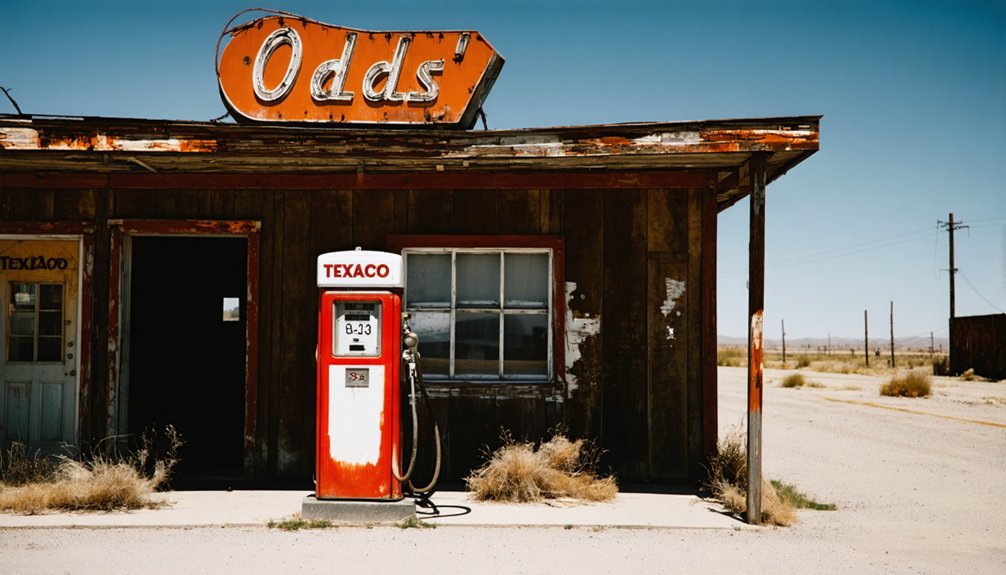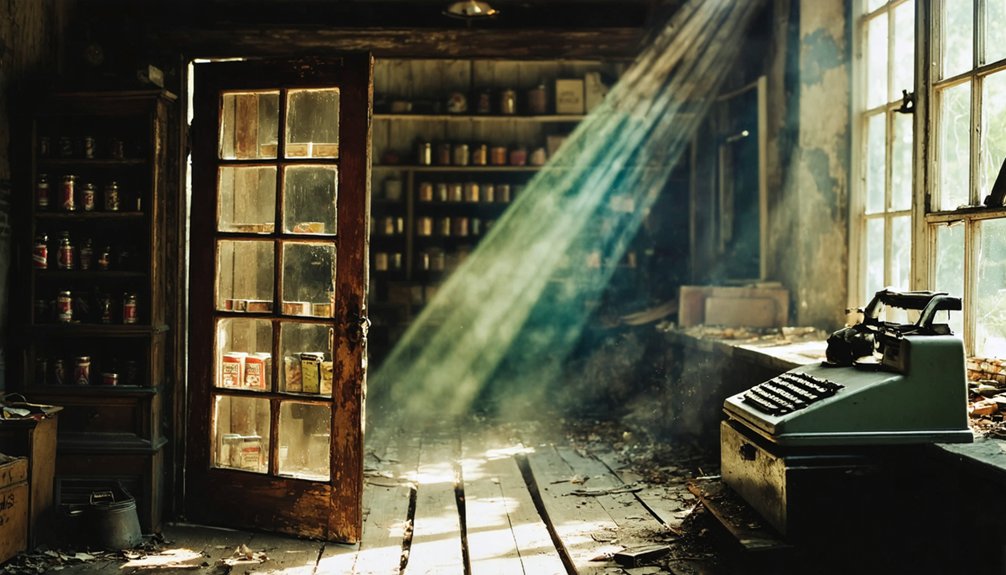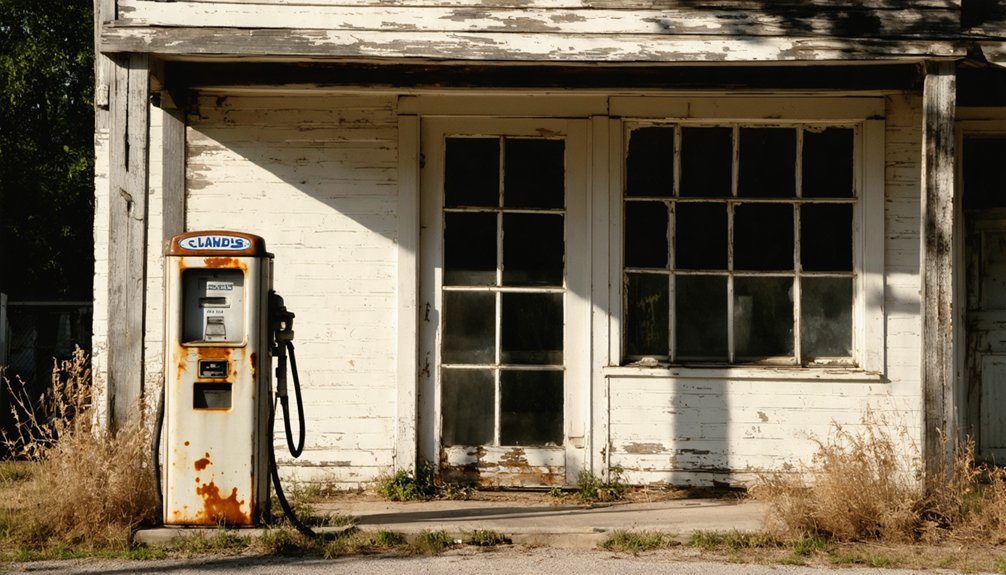You’ll find Odds nestled near the Chinati Mountains in West Texas, where David Barron first set up Buffalo Mott trading post in 1854. The town got its new name in 1899 as buffalo herds dwindled and cattle ranching took hold. At its peak, 150 folks called Odds home, with a cotton gin, general store, and strong farming community. By 1990, she’d gone quiet, leaving only weathered buildings to whisper tales of frontier life.
Key Takeaways
- Originally established as Buffalo Mott in 1854, the town was renamed to Odds in 1899 during its transition from buffalo hunting.
- The town peaked at 150 residents during its heyday, with an economy based on ranching and cotton production.
- Lack of railroad access and post-World War II economic changes led to significant population decline and business closures.
- By 1967, the population had decreased to just 20 residents, marking the town’s steady decline toward ghost town status.
- The town became completely abandoned by 1990, leaving only deteriorating buildings as remnants of its frontier past.
The Birth of Buffalo Mott (1854)
In the spring of 1854, David Barron reckoned there’d be good business in southern Limestone County, so he set up a trading post near Steele’s Creek, ’bout seven miles west of what’d later become Kosse.
That founding marked the birth of Buffalo Mott, a testament to the pioneering spirit of Texas frontier folk.
You’d have found Barron’s trading post serving as the heart of commerce, where settlers’d gather to swap goods and share news.
The founding significance of Buffalo Mott can’t be understated – it became one of them essential outposts that helped tame the wild Texas frontier.
Though it weren’t incorporated, the settlement grew steady-like, with stores, churches, and schools springing up to serve the God-fearing folk who called this slice of Texas home. Among the first pioneers was W. F. Williams, a brave soul who’d fought at the Battle of San Jacinto. In 1899, the settlement underwent a significant change when its name was changed from Buffalo Mott to Odds.
From Buffalo Mott to Odds: The 1899 Transformation
While buffalo herds dwindled across Texas in 1899, folks decided to rename Buffalo Mott to somethin’ more fittin’ – they called it Odds.
You’d hardly recognize the settlement dynamics back then, as them railroad lines started changin’ everything. The iron horse brought new settlers, mostly ranchers and farmers, who weren’t much interested in buffalo huntin’ anymore. Four main herds once migrated seasonally through these parts from Montana.
The community identity shifted right quick as Victorian sensibilities took hold. Gone were the days of frontier livin’ – now you’d find proper schools and tradin’ posts along them rail lines.
Folks were more interested in shippin’ cattle and growin’ crops than trackin’ buffalo. The name change weren’t just about words on paper – it marked the end of one era and the start of another in East Texas. The few remainin’ buffalo in the region found sanctuary at Goodnight’s Palo Duro ranch.
Life in Early Settlement Days
Settlers who carved out a life in early Odds faced the raw, unforgiving Texas frontier head-on. You’d have found these hardy folk living in modest homes built from whatever the land provided, showing true pioneer resilience as they wrestled a living from the South Plains soil.
Life revolved around dryland farming and ranching, with communal cooperation being the key to survival. You’d pitch in to help your neighbors raise barns, harvest crops, or build essential structures. Like many rural Texas settlements facing harsh weather conditions, the community relied heavily on each other’s support to endure the challenges. The region’s energy-dependent economy meant that many similar frontier towns eventually became abandoned when resources ran dry.
The one-room schoolhouse and church served as gathering spots where you’d strengthen bonds with fellow settlers. Local general stores and blacksmith shops kept the community running, while cotton gins later boosted the town’s prospects.
Without railroads nearby, you’d rely on basic roads and the post office to stay connected to the outside world.
Peak Years and Community Growth
During its heyday, you’d have found Odds bustling with nearly 150 souls, though that mightn’t sound like much by city standards.
Folks built their lives around simple but essential community dynamics – a local schoolhouse where children learned their letters and numbers, while parents tended to daily business in town.
Like many settlements across the state that faced economic changes, Odds exemplified how external forces could shape a town’s destiny.
The community’s growth wasn’t tied to any particular boom industry like oil or mining that you’d typically see in other Texas towns.
Unlike many Texas boomtowns driven by oil or mining, Odds grew organically as a humble, self-sustaining community.
Instead, Odds maintained a steady, modest existence through its peak years. You could’ve witnessed the natural ebb and flow of population shifts as families came and went, all while the town served as a self-sufficient hub for its residents. The Cumberland Presbyterian church stood as one of two prominent religious centers in the settlement.
The mail route from Thornton kept townsfolk connected to the wider world beyond their settlement’s boundaries.
Economic Foundations and Local Commerce
You’d find Odds hummin’ with activity during its peak years, with ranchers tradin’ livestock and supplies at the general store while local merchants kept their shops stocked for the steady stream of cowboys and farmers.
The town’s economy got its backbone from cotton production, with the gin workin’ overtime and blacksmiths keepin’ farm equipment runnin’ smooth. Like many Texas towns that relied on single industry bases, the cotton trade shaped the community’s fortunes. Similar to today’s Texas towns facing severe market declines, the local economy was vulnerable to major shifts.
Folks made their livin’ through a web of connected businesses, from feed stores to hardware shops, all servin’ the needs of the surroundin’ ranch and farmland.
Ranching and Local Trade
Like many frontier settlements that sprouted up across Texas in the late 1800s, Buffalo Mott – later known as Odds – built its economic foundation on cattle ranching and local trade.
You’d find ranching families like the Proffitts raisin’ cattle near the Brazos River and Elm Creek, though they faced their share of ranching challenges from Indian raids in the 1860s.
The trade dynamics revolved around what you’d expect in a frontier town – general stores providin’ feed, equipment, and basic supplies.
Local commerce depended heavily on these ranching operations, with blacksmiths and feed suppliers makin’ their living off the cattle business.
When the railroads bypassed Odds and ranching took a downturn, the town couldn’t hold on.
Small Business Operations
The harsh realities of small business life in Odds mirrored many Texas ghost towns of the era. Without railroad access, local merchants struggled to maintain steady supplies and customer traffic.
Business resilience proved mighty difficult when the town’s economy depended solely on ranching, leaving storekeepers vulnerable to every market downturn and population shift.
- Your general store and trading post operators faced dwindling consumer trends as younger folks moved to rail-connected towns.
- Local businesses couldn’t survive once the county seat went elsewhere, taking with it the steady flow of commerce.
- Property disputes and divided land ownership made it near impossible for new enterprises to gain a foothold.
Y’all might’ve noticed how them businesses dried up faster than a West Texas creek bed once the town lost its economic lifeline.
Agricultural Support Services
While farmers worked their land from sunup to sundown, Odds’ agricultural infrastructure kept the whole operation running smooth as silk.
You’d find yourself relying on local mechanics to keep your equipment in working order, and veterinarians making their rounds to tend to your livestock’s health.
When you needed guidance on crop management, agricultural consultants would share their wisdom about the best ways to handle the soil conditions along Steele’s Creek.
Local supply stores stocked everything from seeds to fertilizers, and you could always count on transportation services to haul your cotton, corn, or hay to market.
The general store served as both a trading post and meeting place, where you’d barter goods and share knowledge with fellow farmers about the latest market trends and growing techniques.
The Slow Decline: 1950s and Beyond

Many small Texas towns faced hard times after World War II, and Odds wasn’t spared from the exodus.
As population shifts swept through rural Texas, young folks headed to big cities lookin’ for better opportunities, leaving behind the cotton fields and general stores that once kept Odds hummin’.
Economic changes hit the community hard, with mechanized farmin’ needin’ fewer hands and transportation routes changin’.
- The schoolhouse, where Friday night football games used to draw the whole town, went quiet and closed its doors.
- Local businesses folded up one by one, from the feed store to the post office.
- Roads started growin’ weeds, and empty buildings fell into disrepair.
Geographic Features and Historical Location
Nestled deep in West Texas’s rugged terrain, Odds sat among the desert landscapes and scattered mining settlements that dotted the region near the Chinati Mountains.
You’d find it surrounded by stark geological formations typical of this untamed territory, where silver and quicksilver drew fortune seekers to these parts.
The town’s location proved both a blessing and a curse. While rich mineral resources beckoned prospectors, the harsh desert climate and scarce water made daily life a constant struggle.
You couldn’t farm much in that tough soil, and the isolated position meant you’d better be self-reliant.
Like many ghost towns in Wilson County, Odds fell victim to its remote setting and dependency on finite resources, eventually surrendering to the desert’s unforgiving nature.
Daily Life in a Frontier Community

Life in Odds demanded grit and determination from every soul who called it home. You’d find yourself neck-deep in frontier chores before sunrise, working alongside your kin to keep food on the table and the homestead running.
Frontier life meant endless labor from dawn till dusk, demanding every ounce of strength just to keep your family fed and sheltered.
Seasonal work meant you’d better know your way around a plow, fence post, and hunting rifle if you aimed to survive.
Your daily existence revolved around three essential duties:
- Tending to crops and livestock year-round, from spring planting to fall harvest
- Maintaining your homestead through constant repairs and improvements
- Contributing to community life through church gatherings and informal schooling
Disease could strike without warning, and medical help was scarce. Yet you’d find strength in your neighbors, sharing skills and traditions brought from German, Mexican, and Anglo heritage, making frontier life bearable through cooperation.
Legacy of a Lost Texas Town
While folks can still find Odds on old maps of Limestone County, this once-hopeful frontier settlement now stands as a tribute to Texas’ vanishing rural communities.
Like hundreds of other ghost towns across the Lone Star State, Odds tells a story of rural nostalgia that’ll strike a chord with anyone who remembers the simpler days of agricultural life.
Y’all can trace the town’s community identity back to 1899 when it changed its name from Buffalo Mott and got its post office.
By ’67, only 20 souls remained, and come 1990, Odds had joined the ranks of Texas’ forgotten places.
Today, it’s part of a bigger tale – one of how changing times and economic shifts transformed the countryside.
For history buffs and ghost town seekers, Odds remains a window into Texas’ rural past.
What Remains Today: A Ghost Town’s Footprint
Today’s visitor to Odds’ll find more shadows than substance, with deteriorating buildings standing as quiet witnesses to what once was.
The ghostly structures tell stories of a time when this piece of Texas soil bustled with life and commerce. You’ll see fading memories scattered across the landscape, from abandoned homesteads to rusted oil equipment slowly sinkin’ back into the earth.
What you’ll discover in Odds:
- Crumblin’ infrastructure with unpaved roads leadin’ to nowhere, and power lines that ain’t carried juice in years
- Empty buildings with weather-worn wood and broken windows, some still bearin’ the marks of old business signs
- Scattered remnants of farm equipment and oil derricks, evidence of the industries that once kept this town alive
Frequently Asked Questions
Were There Any Notable Crimes or Lawlessness Incidents in Odds?
Y’all won’t find any recorded crime incidents or law enforcement troubles in Odds. Unlike some of its wilder neighbors, this ghost town didn’t leave behind any tales of outlaw activity.
What Native American Tribes Originally Inhabited the Area Before Settlement?
Y’all would’ve found the Tonkawa and Comanche tribes claimin’ this territory as their cultural heritage. The Tonkawa’s tribal influence was strongest ’round here ‘fore the Comanche pushed ’em out.
Did Any Famous Historical Figures Ever Visit or Stay in Odds?
You won’t find any famous visitors who left their mark on Odds – like tumbleweeds rollin’ through town, historical significance just passed right by this little spot without stoppin’ to rest.
Was There a Cemetery, and Do Any Marked Graves Still Exist?
Y’all can reckon there was a cemetery, but you won’t find much proof nowadays. While marked graves likely existed back then, time and weather’ve worn away most signs of burial grounds.
Did Odds Have Its Own Newspaper or Local Communications System?
Quick as a jackrabbit, you’d find there’s no record of local journalism or historical publications in Odds. You’d have relied on word of mouth and the post office from 1899 onward.
References
- https://www.forttumbleweed.net/odds.html
- https://www.hipcamp.com/journal/camping/texas-ghost-towns/
- https://texashighways.com/travel-news/four-texas-ghost-towns/
- https://www.youtube.com/watch?v=Jkdn0Q6IS0c
- http://texasghosttowns.blogspot.com/2011/
- https://cedarbayoumarina.com/four-ghost-towns-under-lake-texoma/
- https://en.wikipedia.org/wiki/List_of_ghost_towns_in_Texas
- https://www.texasescapes.com/TexasGhostTowns/OddsTexas/OddsTexas.htm
- https://www.texasalmanac.com/places/buffalo-mott
- https://www.hmdb.org/results.asp?Search=County&FilterState=Iowa&County=Motley+County&State=Texas



